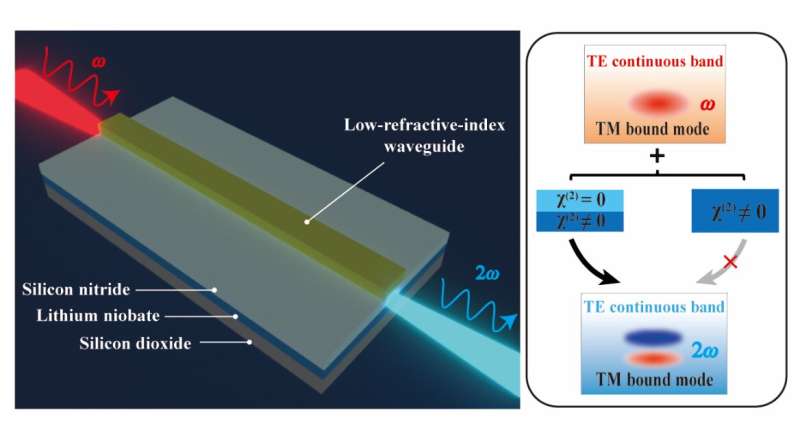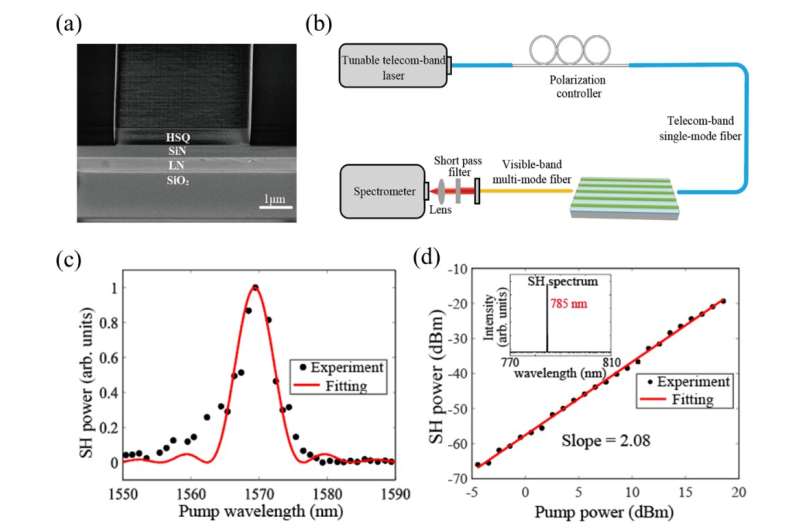Schematic of the BIC-based semi-nonlinear photonic waveguide and its nonlinear frequency conversion. Credit: Xueshi Li et al.
Lithium niobite (LN) with an ultra-wide optical transparent window has shown excellent nonlinear, electro-optic, acoustic-optic, piezoelectric, thermoelectric and photorefractive effects. It is an excellent platform for realizing χ(2) nonlinear photonic devices with low power consumption and high efficiency.
However, phase matching condition among the nonlinear interacting optical fields and advanced nanofabrication techniques are required to realize high-performance LN nonlinear devices. On the one hand, an etchless LN waveguide structure, based on bound states in the continuum (BIC), has been proposed to simplify the nanofabrication process.
On the other hand, most of the modal phase matching (MPM) processes suffer from the significant mode profile disparities between the fundamental frequency (FF) and the second harmonic (SH) waves, resulting in a small or even vanishing nonlinear modal overlap and consequently limiting the conversion efficiency. Alternatively, quasi-phase matching can be achieved by periodic poling of LN waveguides to maximize the nonlinear modal overlap, but the poling process is technologically nontrivial.
Xueshi Li, Dunzhao Wei, Jin Liu et al. from Sun Yat-sen University have reported efficient SHG by harnessing the BIC in a highly engineerable semi-nonlinear waveguide constructed by electron-beam resist waveguide and thin-film silicon nitride (SiN) and LN. This device shows the following advantages: (a) Low propagation losses for FF and SH waves; (b) achievement of MPM; (c) Large nonlinear modal overlap for FF TM00 and SH TM01 mode.
Bound propagation modes of the device were guided by a patterned low-refractive-index (LRI) waveguide but confined in a high refractive SiN/LN thin films. Since TM-like modes are immersed in the high-loss continuous TE-like modes, it will encounter propagation loss due to its coupling with TE-like modes. However, by carefully designing octave-separating BICs for the nonlinear interacting TM modes in such a hybrid structure, one can largely decrease the propagation losses of both FF and SH waves.
In addition, the efficient second-harmonic generation (SHG) not only requires phase matching between the FF and SH modes, but also depends on their nonlinear modal overlap integrals. In the nonlinear conversion between the FF TM00 mode at the telecom band and the SH TM01 mode at the visible band, the nonlinear overlapping integral is not zero any more due to the vanishing χ(2) of SiN, which could achieve a theoretical normalized conversion efficiency of 327% W-1cm-2.
(a) SEM image of the cross-section of the seminonlinear waveguide; (b) Experimental setup for the characterization of SHG; (c) Nonlinear emission intensity as a function of pumping wavelength with a sinc²-function fitting; (d) Power dependence of the generated nonlinear signals at the pumping wavelength of 1570 nm. Credit: Xueshi Li et al.
Such devices can be fabricated by simple procedures. Firstly, a SiN layer of similar thickness is deposited on the LN thin film. Then a LRI waveguide structure is fabricated by electron-beam lithography on top of the SiN layer. the processes of etching and ferroelectric domain poling are not involved. A fiber-coupled optical system is used to characterize the SHG. Fixing the FF wavelength at the phase matching point of 1570 nm, the power dependence of SH wave is measured. The on-chip normalized conversion efficiency of the device is calculated to be 4.05% W-1cm-2.
The research is published in Light: Science & Applications.
More information: Xueshi Li et al, Efficient second harmonic generation by harnessing bound states in the continuum in semi-nonlinear etchless lithium niobate waveguides, Light: Science & Applications (2022). DOI: 10.1038/s41377-022-01017-x
Journal information: Light: Science & Applications
Provided by Chinese Academy of Sciences

























